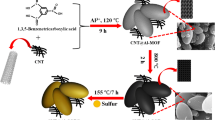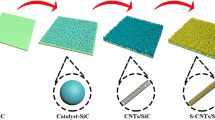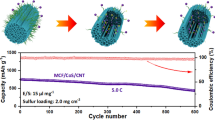Abstract
The lithium-sulfur cathode material is one of the potential electrode materials used in the Li-sulfur battery due to its high capacity. A rapid heating process was used to synthesis the sulfur nanosheets. Hierarchical porous carbon materials were prepared by carbonization of silk cocoon (sC). The sulfur nanosheets and carbonized silk cocoon nanocomposite were prepared by simple melt-diffusion method. The morphology and anchoring of sulfur nanosheets on carbonized silk cocoon were confirmed by SEM and TEM studies. The Raman spectroscopy measurement was employed to verify the formation of graphitic carbon nanostructure. The electrochemical performance of sulfur and carbonized silk cocoon (S-sC) nanocomposite sample showed 1231 mAh/g discharge capacity at 0.05 C. The capacity retention of the sample was about 997 mAh/g after 50 cycles. This nanocomposite material plays a vital role in improving electrochemical performance. The sulfur nanosheets anchored on silk fiber will be an ideal cathode candidate material for lithium-sulfur batteries.







Similar content being viewed by others
References
H. Chen, C. Wang, Y. Dai, S. Qiu, J. Yang, W. Lu, L. Chen, Rational design of cathode structure for high rate performance lithium-sulfur batteries. Nano Lett. 15, 5443–5448 (2015). https://doi.org/10.1021/acs.nanolett.5b01837
S.S. Zhang, Liquid electrolyte lithium/sulfur battery: fundamental chemistry, problems, and solutions. J. Power Sources 231, 153–162 (2013). https://doi.org/10.1016/j.jpowsour.2012.12.102
Article R (2012) Li–O2 and Li–S batteries with high energy storage. 11:19–30. https://doi.org/10.1038/NMAT3191
Y. Yin, S. Xin, Y. Guo, L. Wan, Lithium–sulfur batteries: electrochemistry, materials, and prospects. Angewandte, 13186–13200 (2013). https://doi.org/10.1002/anie.201304762
Y. Liu, M. Yao, L. Zhang, Z. Niu, Large-scale fabrication of reduced graphene oxide-sulfur composite films for flexible lithium-sulfur batteries. J Energy Chem. 38, 199–206 (2019). https://doi.org/10.1016/j.jechem.2019.03.034
K. Chen, J. Cao, Q. Lu, Q. Wang, M. Yao, M. Han, Z. Niu, J. Chen, Conductive porous vanadium nitride/graphene composite as chemical anchor of polysulfides for lithium-sulfur batteries. Nano Res. 11, 1345–1357 (2018). https://doi.org/10.1007/s12274-017-1749-2
X. Yang, X Li, K Adair, et al, Structural Design of Lithium–Sulfur Batteries: from Fundamental Research to Practical Application. Springer Singapore (2018)
X. Ji, K.T. Lee, L.F. Nazar, A highly ordered nanostructured carbon–sulphur cathode for lithium–sulphur batteries. Nat. Mater. 8, 500–506 (2009). https://doi.org/10.1038/nmat2460
S. Dutta, A. Bhaumik, K.C.-W. Wu, Hierarchically porous carbon derived from polymers and biomass: effect of interconnected pores on energy applications. Energy Environ. Sci. 7, 3574–3592 (2014). https://doi.org/10.1039/C4EE01075B
S. Lu, Y. Chen, J. Zhou, et al., A sheet-like carbon matrix hosted sulfur as cathode for batteries. Nat Publ Gr, 1–10 (2016). https://doi.org/10.1038/srep20445
M. Xiang, Y. Wang, J. Wu, Y. Guo, H. Wu, Y. Zhang, H. Liu, Natural silk cocoon derived nitrogen-doped porous carbon nanosheets for high performance lithium-sulfur batteries. Electrochim. Acta 227, 7–16 (2017). https://doi.org/10.1016/j.electacta.2016.11.139
Y. Meng, Novel hierarchically porous carbon materials obtained from natural biopolymer as host matrixes for lithium–sulfur battery applications. ACS Appl. Mater. Interfaces 6, 13174–13182 (2014). https://doi.org/10.1021/am503069j
R. Fang, S. Zhao, S. Pei, X. Qian, P.X. Hou, H.M. Cheng, C. Liu, F. Li, Toward more reliable lithium-sulfur batteries: an all-graphene cathode structure. ACS Nano 10, 8676–8682 (2016). https://doi.org/10.1021/acsnano.6b04019
M.-Q. Zhao, M. Sedran, Z. Ling, et al., Synthesis of carbon/sulfur nanolaminates by electrochemical extraction of titanium from Ti2SC. Angew. Chem. Int. Ed. Eng. 54, 4810–4814 (2015). https://doi.org/10.1002/anie.201500110
G. Li, J. Sun, W. Hou, S. Jiang, Y. Huang, J. Geng, Three-dimensional porous carbon composites containing high sulfur nanoparticle content for high-performance lithium–sulfur batteries. Nat. Commun. 7, 10601 (2016). https://doi.org/10.1038/ncomms10601
G. Zhou, E. Paek, G.S. Hwang, A. Manthiram, Long-life Li/polysulphide batteries with high sulphur loading enabled by lightweight three-dimensional nitrogen/sulphur-codoped graphene sponge. Nat. Commun. 6, 7760 (2015). https://doi.org/10.1038/ncomms8760
S.Y. Cho, Y.S. Yun, S. Lee, D. Jang, K.Y. Park, J.K. Kim, B.H. Kim, K. Kang, D.L. Kaplan, H.J. Jin, Carbonization of a stable β-sheet-rich silk protein into a pseudographitic pyroprotein. Nat. Commun. 6, 7145 (2015). https://doi.org/10.1038/ncomms8145
Y. Zhang, X. Xia, X. Wang, C.D. Gu, J.P. Tu, Graphene oxide modified metallic lithium electrode and its electrochemical performances in lithium–sulfur full batteries and symmetric lithium–metal coin cells. RSC Adv. 6, 66161–66168 (2016). https://doi.org/10.1039/C6RA13039A
X.-B. Yang, W. Zhu, K. Qin, H.-Y. Wang, Preparation of lamellar carbon matrix for sulfur as cathode material of lithium-sulfur batteries. Electrochim. Acta 143, 374–382 (2014). https://doi.org/10.1016/j.electacta.2014.07.080
M. Chen, S. Jiang, C. Huang, X. Wang, S. Cai, K. Xiang, Y. Zhang, J. Xue, Honeycomb-like nitrogen and sulfur dual-doped hierarchical porous biomass-derived carbon for lithium-sulfur batteries. ChemSusChem 10, 1803–1812 (2017). https://doi.org/10.1002/cssc.201700050
R. Demir-cakan, M. Morcrette, F. Nouar, et al., Cathode composites for Li–S batteries via the use of oxygenated porous architectures. J. Am. Chem. Soc. 133, 16154–16160 (2011)
R. Chulliyote, H. Hareendrakrishnakumar, M. Raja, J.M. Gladis, A.M. Stephan, Enhanced cyclability using a polyindole modified cathode material for lithium sulphur batteries. Sustain Energy Fuels 1, 1774–1781 (2017). https://doi.org/10.1039/C7SE00210F
Y. Peng, Y. Zhang, J. Huang, Y. Wang, H. Li, B.J. Hwang, J. Zhao, Nitrogen and oxygen dual-doped hollow carbon nanospheres derived from catechol/polyamine as sulfur hosts for advanced lithium sulfur batteries. Carbon N Y 124, 23–33 (2017). https://doi.org/10.1016/j.carbon.2017.08.035
J. Sun, L. Xiao, S. Jiang, G. Li, Y. Huang, J. Geng, Fluorine-doped SnO2@graphene porous composite for high capacity lithium-ion batteries. Chem. Mater. 27, 4594–4603 (2015). https://doi.org/10.1021/acs.chemmater.5b00885
E.H. Mohan, S. Anandan, B.V.A. Rao, T.N. Rao Neem leaf-derived micro and mesoporous carbon as an efficient polysulfide inhibitor for sulfur cathode in a Li-S battery. 62–64. https://doi.org/10.1246/cl.180726 (2019)
M. Xue, C. Chen, Y. Tan, Z. Ren, B. Li, C. Zhang, Mangosteen peel-derived porous carbon: synthesis and its application in the sulfur cathode for lithium sulfur battery. J. Mater. Sci. 53, –11077 (2018). https://doi.org/10.1007/s10853-018-2370-9
L. Zhang, Y. Wang, B. Peng, W. Yu, H. Wang, T. Wang, B. Deng, L. Chai, K. Zhang, J. Wang, Preparation of a macroscopic, robust carbon-fiber monolith from filamentous fungi and its application in Li–S batteries. Green Chem. 16, 3926–3934 (2014). https://doi.org/10.1039/c4gc00761a
Z. Deng, Z. Zhang, Y. Lai, J. Liu, J. Li, Y. Liu, Electrochemical impedance spectroscopy study of a lithium/sulfur battery: modeling and analysis of capacity fading. J. Electrochem. Soc. 160, A553–A558 (2013). https://doi.org/10.1149/2.026304jes
B. Ding, L. Shen, G. Xu, P. Nie, X. Zhang, Encapsulating sulfur into mesoporous TiO2 host as a high performance cathode for lithium–sulfur battery. Electrochim. Acta 107, 78–84 (2013). https://doi.org/10.1016/j.electacta.2013.06.009
Acknowledgements
The authors acknowledge the partial support from the VGST, Department of IT, BT, Government of Karnataka with Grant No. VGST/CESEM/2012-13/281.
Author information
Authors and Affiliations
Corresponding author
Ethics declarations
Competing interest
The authors declare no competing interests.
Rights and permissions
About this article
Cite this article
Shastri, M., Sriramoju, J.B., Muniyappa, M. et al. Silk cocoon derived carbon and sulfur nanosheets as cathode material for Li-S battery application. emergent mater. 4, 1329–1337 (2021). https://doi.org/10.1007/s42247-021-00218-1
Received:
Accepted:
Published:
Issue Date:
DOI: https://doi.org/10.1007/s42247-021-00218-1




